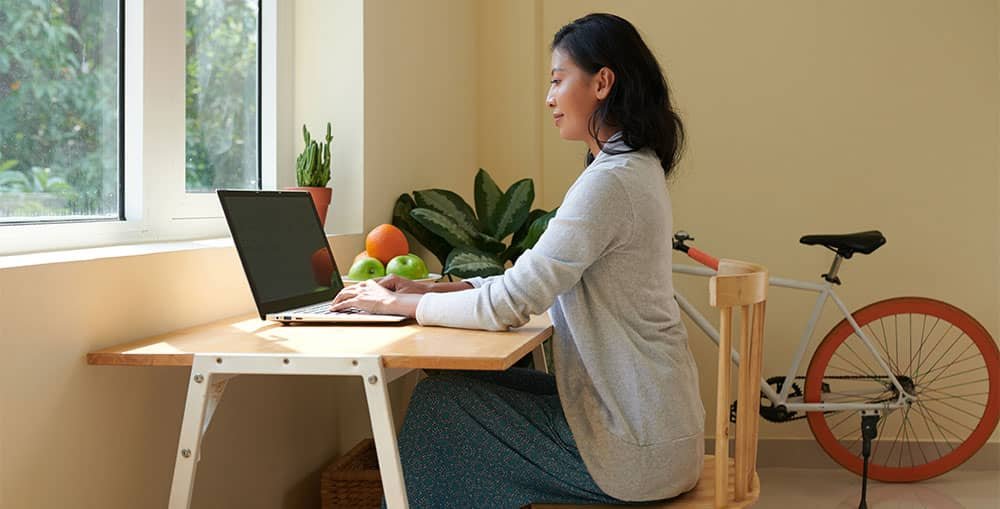The Benefits of RMT Massage for Office Workers
Table of Contents Show
Quick Summary
Discover how regular massage therapy can transform office workers' daily grind. This article explores the crucial role of massage in alleviating common workplace ailments like poor posture, muscle stiffness, and stress. Learn practical tips for integrating massage into your wellness routine and understand why maintaining good posture is essential for your professional performance and long-term health.
In a bustling city like Vancouver, where the skyline is punctuated with offices, the typical nine-hour workday often chains us to our desks, with little opportunity for physical movement or stretching.
This sedentary lifestyle not only contributes to fatigue—further amplified by daily commutes and demanding workloads—but also takes a toll on our bodies in less visible yet significant ways.
Take, for instance, Sarah, a fictional client who came to our clinic with a stiff neck, sore lower back, and frequent headaches.
Like many office workers, Sarah spent much of her day slouched over her computer, her posture slowly deteriorating until the discomfort became unavoidable.
Through a tailored program of regular massage therapy, Sarah experienced significant relief from her pain, improved her posture, and reduced her stress levels.
What we hope you will be able to take from this article is why it is important to not only be aware of your posture but also, like Sarah, what you can do to prevent or help navigate the challenges of office work.
We will delve into the critical areas affected by prolonged sitting and how massage therapy can serve as a powerful tool in your wellness regimen.
By the end of this read, I hope to increase your awareness of the physical costs of office employment and inspire you to take actionable steps toward incorporating massage therapy into your life for enhanced well-being and productivity.
You may or may not be aware of this, but avoiding bad posture while at your desk is important, and this article will help explain why.
Why Office Workers Need Massage Therapy
In the landscape of modern work culture, where office chairs become thrones and screens hold court, physical care often goes overlooked. Studies have been made on the benefits of massage therapy and its ability to decrease stress and physical alignments from long periods of sitting.
Would it even shock you that many workers overlook the gradual yet profound impact of desk-bound routines on their health, particularly regarding posture?
It probably would not shock you, as honestly, it is easy to dismiss the slight backache or the occasional stiffness as transient discomforts that a good night's sleep will remedy.
However, these minor issues can develop into more severe problems affecting work performance and overall quality of life.
In the workspace, poor posture isn't just about slouching—it also encompasses how we position our arms and legs and how long we remain static in one pose.
These habits can compound, leading to a cycle of pain and discomfort that extends beyond office hours into personal life. Here are a few potential impacts:
Increased Physical Discomfort: Slouching and poor ergonomic practices can lead to chronic pain in the neck, shoulders, and back.
Elevated Stress Levels: Physical discomfort often translates into mental stress, which can further exacerbate health issues.
Reduced Mobility: Stiffness and decreased range of motion can result from muscles being in prolonged tension.
While these issues are briefly touched upon here, they are explored in more detail later in this article, offering insights into how massage therapy can serve as a corrective and preventive measure to maintain wellness in the workplace.
So, continue reading to understand the benefits of incorporating regular massage therapy into your routine.
We will discuss the benefits and how they can be tailored to counteract the occupational hazards of office work.
Good posture prevents fatigue and improves muscle efficiency and health.
What Happens to Your Body When You Sit for Long Periods of Time?
Sitting might seem like a benign activity, especially when it's part of your daily work routine, but its impact on the body can be surprisingly extensive and detrimental over time.
Prolonged sitting not only affects posture and spine health but also leads to significant changes in musculature, particularly in the large muscles of the legs and buttocks.
Muscle Atrophy and Weakness: The large leg and gluteal muscles are vital for walking and maintaining balance. When you sit for extended periods, these muscles are inactive and begin to weaken—a condition known as muscle atrophy.
Weakened gluteal and leg muscles diminish your stability, making you more susceptible to falls and injuries, which can be particularly problematic as you age.
For instance, let's revisit Sarah's story. When she first came to our clinic, she was not only suffering from back and neck pain but also complained of feeling less stable on her feet.
During our assessment, it became evident that the lack of activity caused by long hours at her desk had led to a significant weakening of her gluteal muscles, contributing to her overall discomfort and instability.
This instability also made her more prone to strains when she attempted to be more active, creating a vicious cycle of pain and injury.
Impact on Overall Mobility: The weakening of these crucial muscles affects more than just stability; it impacts overall mobility. The less these muscles are used, the shorter and tighter the hip flexors become, leading to a condition known as hip flexor tightness. This tightness can alter how you walk and even affect your ability to stand up straight after long periods of sitting.
A massage therapist worked with Sarah to strengthen her weakened muscles and release the tightness in her hips by incorporating targeted massage therapy and specific exercises.
Over time, not only did her stability improve, but she also noticed a significant reduction in her daily discomfort and an enhanced ability to perform her routine activities without pain.
This example underscores the importance of being aware of the hidden dangers of prolonged sitting and actively taking steps to counteract its effects.
It also helps to take time for yourself when you are feeling tight; massage therapy plays a crucial role by alleviating pain and facilitating the reactivation and strengthening of these crucial muscle groups.
5 Reasons Office Workers Need Massage Therapy
Massage therapy is more than just a means to relax; it's crucial for maintaining and enhancing overall health, especially for those spending long hours at desks.
While this may have been mentioned throughout the article, we still want to explain why these are the main reasons why an office worker should consider massage therapy in their wellness regimen:
1. Poor Posture
Long hours in front of a computer often lead to slouching and poor posture, which can cause a range of issues, from neck and back pain to long-term spinal complications.
Techniques such as deep tissue massage are particularly effective at addressing this issue. By targeting the deeper layers of muscle and connective tissue, deep tissue massage helps release chronic muscle tension and knots. Regular sessions can significantly improve posture by realigning the body and relieving the pressure that leads to postural imbalances.
2. Stress
The pressure of deadlines and daily workload can build up significant stress, which often manifests physically in the form of tight shoulders, headaches, and muscle aches.
Swedish massage, known for its relaxing and gentle techniques, can play a pivotal role in stress reduction. Through soothing strokes and rhythmic tapping, Swedish massage promotes relaxation and boosts serotonin and dopamine levels, thereby improving mood and lowering stress levels.
3. Limited Mobility
Sitting for prolonged periods can restrict the range of motion and flexibility due to tightened muscles and joints.
Myofascial Release is a specialized physical therapy that helps release tightness in the fascia—the connective tissue surrounding muscles—improving mobility and reducing pain. This technique involves applying gentle, sustained pressure into the myofascial connective tissue restrictions to eliminate pain and restore motion.
4. Productivity
A healthy, pain-free body is inherently more productive. Tension and discomfort can distract from focus and decrease efficiency.
Booking regular massage therapy sessions not only alleviates these physical ailments but also helps rejuvenate the mind. This mental clarity and decreased physical discomfort enable better focus, creativity, and overall productivity at work.
5. Preventing Pain
Preventative care is often overlooked until pain becomes a significant problem. Massage therapy can be a proactive measure to prevent the onset of musculoskeletal issues that are common in office environments.
Techniques like trigger point therapy focus on areas of tight muscle fibres that can form in your muscles after injuries or overuse. Regular massage helps maintain muscle health, keeps the body flexible, and reduces the likelihood of pain developing from repetitive strain and other occupational hazards.
Regular massage therapy prevents disorders and enhances overall life quality.
FAQ
What is the best massage for office workers?
Deep-tissue massages offer more than just physical relief for office workers. They are also known for being excellent for those with chronic pain and muscle tension, as they reach deeper layers of muscle and fascia to alleviate deep-seated discomfort.
What are the reasons you might seek massage therapy?
Seeking massage therapy can bring a multitude of benefits that enhance both physical health and overall well-being:
Improved Circulation: Enhances blood flow to muscles, promoting healthier body function.
Decreased Muscle Stiffness and Joint Inflammation: Helps relieve the discomfort associated with prolonged sitting or physical exertion.
Better Quality of Sleep: Contributes to more restful nights, which is crucial for mental and physical recovery.
Quicker Recovery Between Workouts: Reduces recovery time and enhances the effects of physical training.
Improved Flexibility: Increases range of motion and reduces the risk of injuries.
Less Pain and Soreness: Alleviates acute and chronic pain conditions, enhancing daily comfort.
Strengthened Immune Response: Regular massage may boost the immune system by stimulating the lymphatic system.
What are the benefits of a professional massage?
Professional massage therapy offers extensive physical benefits that contribute to a healthier, more vibrant life:
Improved Circulation: Facilitates better blood flow, enhancing oxygen and nutrient delivery to muscle cells.
Decreased Muscle Stiffness: Relieves tightness, particularly in common problem areas like the neck, shoulders, and back.
Decreased Joint Inflammation: Helps reduce joint pain and swelling, improving mobility.
Better Quality of Sleep: Promotes relaxation and helps alleviate conditions that interfere with sleep, such as chronic pain.
Quicker Recovery Between Workouts: Aids in muscle recovery and decreases the likelihood of muscle soreness.
Improved Flexibility: Helps maintain and improve overall body flexibility, preventing muscle injuries.
Less Pain and Soreness: Directly addresses the physical manifestations of stress and strain on the body.
Strengthened Immune Response: Regular sessions can help bolster immunity by enhancing the body’s natural defence mechanisms.
Conclusion: Prioritizing Your Well-being in the Workplace
As we’ve explored throughout this article, the demands of office work, though often sedentary, can significantly strain your body and mind.
Prolonged sitting affects posture and musculoskeletal health as well as overall well-being, leading to decreased mobility, increased stress, and other physical discomforts. It's crucial to recognize these impacts early and take proactive steps to address them.
Remember, simple habits can make a substantial difference.
Make it a practice to adjust your posture regularly, stand and stretch every hour, and integrate short walks into your day. These small changes can help mitigate the risks associated with long hours of sitting and are essential for maintaining your health and vigour.
However, while these practices are beneficial, sometimes they might not be enough to reverse the toll that office life can take on your body.
This is where professional massage therapy comes into play.
Regular massage sessions soothe tired and aching muscles and enhance your circulation, flexibility, and immune system, contributing to a heightened state of physical and mental health.
So, take this as a reminder to prioritize yourself.
Allow yourself the time to receive a professional massage now and then—especially when you feel tight, overworked, or simply low in energy.
Not only is it an enjoyable way to relax and unwind, but it's also a vital part of a holistic approach to health care. Consider it not just a luxury but a necessary component of a balanced lifestyle that empowers you to perform at your best in all areas of life.
By caring for your body with the same diligence that you apply to your work, you'll enhance your immediate comfort and productivity and invest in your long-term health and wellness.
If you have any further doubts or questions regarding this subject or another treatment, contact one of our experienced Acupuncturists or Registered Massage Therapists here at West End Wellness Clinic. You can either give us a call or make an appointment.
Disclaimer: Please remember this article is for informational purposes only and should not replace professional medical advice. Please consult a healthcare provider or someone with the correct qualifications before starting any new exercise or treatment program.




